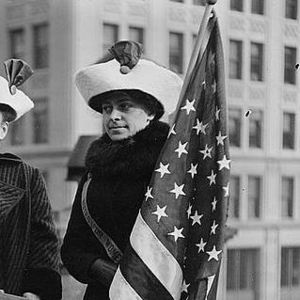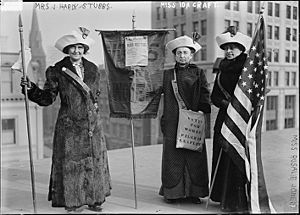Rosalie Gardiner Jones facts for kids
Quick facts for kids
Rosalie Gardiner Jones
|
|
|---|---|
 |
|
| Born | February 24, 1883 |
| Died | January 12, 1978 (aged 94) |
| Nationality | American |
| Occupation | Suffragette |
| Spouse(s) | Clarence Dill (m. 1927–1936, divorce) |
| Parents |
|
Rosalie Gardiner Jones (born February 24, 1883 – died January 12, 1978) was an American suffragette. A suffragette was a woman who actively fought for women's right to vote. Rosalie was inspired by British suffragettes like the Pankhursts. She organized long marches to bring attention to the cause of women's suffrage. Because of her strong leadership and many followers, she was often called "General Jones."
Contents
Rosalie Jones's Early Life and Education
Rosalie Jones was born in Cold Spring Harbor, New York. Her mother, Mary Elizabeth Jones, came from a wealthy family. Her father was Dr. Oliver Livingston Jones Sr. Rosalie and her mother had very different ideas about women's right to vote. While her mother was against women voting, Rosalie was a strong supporter. She was even the president of the National American Woman Suffrage Association in her county.
Rosalie went to Adelphi College in Brooklyn and earned a Bachelor of Arts degree. She then studied law at Brooklyn Law School. She later earned a law degree from George Washington College of Law. Rosalie also received a Doctor of Civil Law degree from American University. She wrote important papers on topics like the labor party in England.
Rosalie Jones's Fight for Women's Rights

Rosalie Jones was greatly influenced by British suffragettes, especially the "Pankhursts." They were famous for their bold actions to gain voting rights for women. Rosalie organized marches similar to those held in Britain. These marches helped draw public attention to the suffrage movement in the United States.
Famous Suffrage Marches
Some of her most famous marches include a walk to Albany, New York in December 1912. Another big march was to Washington D.C. in February 1913. During her march from Manhattan, New York to Albany, she led over 200 women. They walked more than 175 miles in just thirteen days. Even though her mother did not support her, Rosalie continued to lead these important marches.
In early 1913, General Rosalie Jones and her group, called "pilgrims," planned to reach the Capitol Building in Washington D.C. People were excited to welcome the 225 women. One marcher, Miss Constance Leupp, arrived early and said the march was fun, not hard. General Genevieve Wilmsatt, who led a group of horsewomen, met Jones's pilgrims. She escorted them into the city of Washington.
"General Jones" and the 19th Amendment
Rosalie was known as "General Jones" because she was a strong leader. She believed in fighting hard for what was right. She was not afraid to do dramatic things to make her point. Her marches might not have been as famous as those organized by Alice Paul. However, Jones was a very important leader. Her efforts and the work of many other suffragettes helped lead to a major change. This change was the passage of the 19th Amendment on June 4, 1919. This amendment finally gave women the right to vote across the United States. It was officially approved on August 18, 1920.
Later Life and Legacy
After the suffrage protests, Rosalie Jones continued to fight for her beliefs. In 1925, she protested against Governor Alfred E. Smith. She demanded that he remove Robert Moses from his position. She felt he was taking people's land unfairly.
Rosalie later returned to her home on Long Island. She lived there by herself. In the following years, she continued to challenge traditions. She even raised goats on her property. She also had disagreements with her neighbors and family members.
Personal Life and Death
On March 15, 1927, Rosalie Jones married Clarence Dill. He was a Washington United States Senator. Their marriage ended in divorce, which was widely reported. After her divorce, Rosalie ran for a position in Congress in November 1936. She ran as a Democrat but was not elected.
Rosalie Jones died on January 12, 1978. Her ashes were scattered near her mother's tomb at St. John Episcopal Church in Cold Spring Harbor, New York.
Images for kids
See also
 In Spanish: Rosalie Gardiner Jones para niños
In Spanish: Rosalie Gardiner Jones para niños



